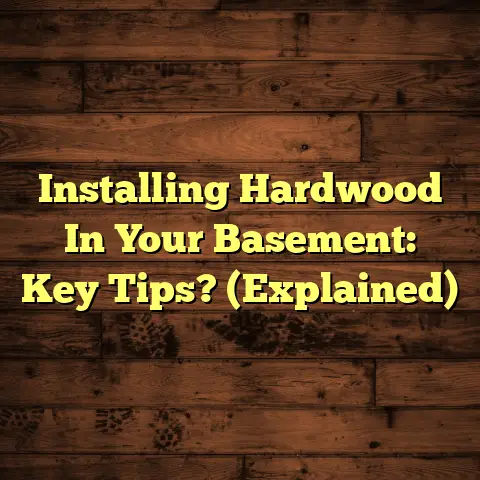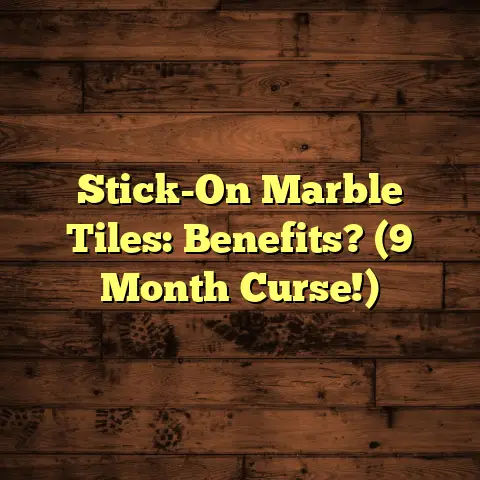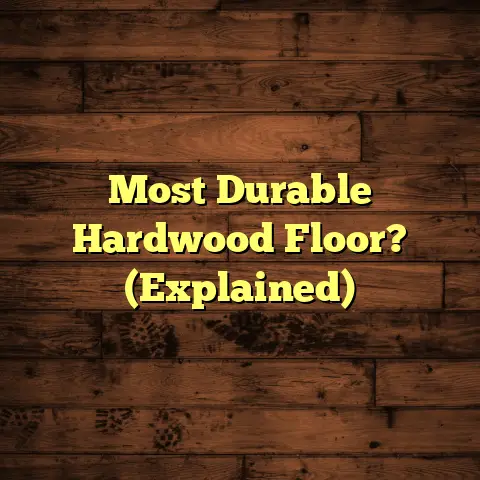Under Wood Floors: What’s Essential? (5 Must-Knows!)
Ever walked into a room and just felt… right?
For me, and I bet for you too, a lot of that feeling comes from the floor.
Think about it: the warm glow of sunlit hardwood, the satisfying creak underfoot that whispers stories of family gatherings, holiday celebrations, and quiet evenings.
I remember as a kid, my siblings and I would spend hours on our old oak floor, building Lego kingdoms and racing toy cars.
Those floors weren’t just surfaces; they were the canvas for our laughter, our explorations, and even the occasional tumble.
But what makes those floors so special, so enduring? It’s not just the wood you see.
It’s what’s underneath that really counts.
And that’s what we’re diving into today.
So, grab a coffee, settle in, and let’s uncover the secrets hiding beneath your beautiful wood floors.
1. The Foundation – Understanding the Subfloor
Okay, let’s start with the basics: the subfloor.
Think of it as the unsung hero of your flooring system. It’s the structural layer directly beneath your finished floor, providing a stable and level surface for everything else.
Without a solid subfloor, your wood floor is destined for problems – squeaks, unevenness, and premature wear, you name it.
What is it, exactly?
The subfloor is the bottom most structural layer of your floor that is directly connected to the floor joists. The floor joists provide support for the subfloor.
Common Suspects: Subfloor Materials
Most commonly, you’ll find subfloors made from either plywood or oriented strand board (OSB).
-
Plywood: This is made from layers of wood veneer glued together. It’s known for its strength and stability. Think of it like a laminated fortress for your floor.
-
OSB (Oriented Strand Board): This is engineered wood made from compressed wood strands. It’s generally more affordable than plywood, but can be more susceptible to moisture damage if not properly sealed.
Why the Subfloor Matters (A Lot!)
The condition of your subfloor has a massive impact on the longevity and performance of your wood flooring. A solid, level, and dry subfloor means a happy, long-lasting wood floor.
A damaged subfloor? Well, that’s a recipe for disaster.
Spotting Trouble: Signs of Subfloor Damage
Keep an eye (and ear) out for these red flags:
-
Moisture Issues: Water stains, discoloration, or even mold growth are serious signs of moisture intrusion.
-
Warping: Uneven surfaces or noticeable dips in the subfloor can indicate warping due to moisture or structural problems.
-
Squeaking Noises: Those annoying squeaks are often a sign of loose subfloor panels or movement between the subfloor and joists.
My Real-World Experience
I once worked on a project where the homeowner insisted on installing beautiful hardwood over an old, water-damaged subfloor. I advised against it, but they were determined to save money by skipping the subfloor repair.
Fast forward six months, and I got a frantic call. The hardwood was buckling, squeaking like crazy, and showing signs of mold. They ended up having to rip out the entire floor and replace the subfloor anyway.
Trust me, folks, addressing subfloor issues upfront will save you a ton of headaches (and money) down the road.
Pro Tip: Before installing any new flooring, always check the subfloor for levelness, moisture content, and structural integrity. A little preventative maintenance goes a long way!
2. Moisture Management – The Silent Enemy
Okay, now let’s talk about the arch-nemesis of wood floors: moisture.
I can’t stress this enough: moisture control is absolutely critical when it comes to wood flooring.
Think of it like this: wood is a natural material, and it’s constantly reacting to changes in humidity. When it absorbs moisture, it expands; when it dries out, it contracts.
Humidity’s Impact: The Expansion-Contraction Dance
High humidity levels cause wood to absorb moisture from the air, leading to expansion. This can put pressure on the flooring, causing it to buckle or warp.
Low humidity levels, on the other hand, cause wood to lose moisture, leading to contraction. This can create gaps between boards and make the floor more susceptible to damage.
The Vapor Barrier: Your First Line of Defense
A vapor barrier is a material designed to prevent moisture from passing through it. It’s typically installed between the subfloor and the wood flooring to protect the wood from moisture rising from the ground or crawl space.
-
Types of Vapor Barriers: Common materials include polyethylene film, asphalt-saturated kraft paper, and specialized underlayments with built-in vapor barriers.
-
Installation is Key: Proper installation is crucial for a vapor barrier to be effective. Seams should be overlapped and taped to create a continuous barrier.
Measuring Moisture: Tools and Techniques
Before installing any wood flooring, it’s essential to measure the moisture content of both the subfloor and the wood itself.
-
Moisture Meters: These devices use electrical resistance or capacitance to measure the amount of moisture in wood and other materials.
-
Acclimation is Non-Negotiable: Allow the wood flooring to acclimate to the environment for several days before installation. This allows the wood to adjust to the local humidity levels, minimizing expansion and contraction after installation.
A Little History Lesson
Back in the day, moisture management wasn’t always a priority. Old homes often lacked proper vapor barriers and had poor ventilation, leading to widespread moisture problems.
As building science has advanced, we’ve learned a lot about the importance of moisture control. Modern homes are typically built with better vapor barriers, improved ventilation systems, and moisture-resistant materials.
My Personal Horror Story
I once inspected a home where the homeowner had installed beautiful bamboo flooring in their basement without a vapor barrier.
The basement had a history of moisture problems, but they ignored the warnings and went ahead with the installation.
Within a few months, the bamboo started to buckle and warp, and mold began to grow underneath the flooring. It was a costly and heartbreaking mistake.
Key Takeaway: Don’t underestimate the power of moisture management. Invest in a good vapor barrier, measure moisture levels before installation, and take steps to control humidity in your home.
Your wood floors will thank you for it!
3. Insulation and Soundproofing – Creating Comfort
Let’s move on to something that’s often overlooked but can make a huge difference in your home’s comfort: insulation and soundproofing.
Now, you might be thinking, “Insulation under my wood floors? Isn’t that just for walls and attics?”
Well, think again!
Proper insulation under your floors can significantly improve energy efficiency, reduce noise transmission, and even make your floors feel warmer underfoot.
Insulation and Energy Efficiency: A Winning Combo
Insulation acts as a thermal barrier, preventing heat from escaping in the winter and keeping heat out in the summer.
This can lead to significant energy savings and a more comfortable living environment.
- Benefits of Insulation:
- Reduced energy bills
- More consistent temperatures
- Improved comfort
- Reduced carbon footprint
Soundproofing: Peace and Quiet, Please!
If you live in a multi-story home or apartment, soundproofing is a must. Footsteps, voices, and other noises can easily travel through floors, creating a disruptive and unpleasant living environment.
Soundproofing materials can help to absorb sound waves, reducing noise transmission and creating a more peaceful space.
- Benefits of Soundproofing:
- Reduced noise from footsteps and voices
- Improved privacy
- More peaceful living environment
- Increased property value
Insulation Options: What’s Underneath Matters
-
Fiberglass Insulation: A traditional and affordable option, fiberglass batts can be installed between floor joists to provide thermal insulation.
-
Spray Foam Insulation: This type of insulation expands to fill gaps and cracks, creating a tight seal that prevents air leakage and provides excellent insulation.
-
Rigid Foam Boards: These boards can be cut and fitted between floor joists to provide a layer of insulation.
Soundproofing Materials: Hush, Hush
-
Soundproofing Mats: These mats are typically made from recycled rubber or foam and are installed directly under the wood flooring to absorb sound waves.
-
Acoustic Underlayments: These underlayments are designed to reduce impact noise and airborne noise.
Real-Life Transformations
I’ve seen firsthand how insulation and soundproofing can transform living spaces.
I once worked on a project where the homeowners had a persistent problem with noise from their upstairs neighbors. They could hear every footstep, every conversation, and every TV show.
We installed soundproofing mats under their new wood floors, and the difference was night and day. They finally had the peace and quiet they had been longing for.
The Numbers Don’t Lie
According to the U.S. Department of Energy, proper insulation can save homeowners up to 15% on their heating and cooling costs.
Studies have also shown that soundproofing can significantly improve sleep quality and reduce stress levels.
My Personal Recommendation
If you’re planning to install wood floors, I highly recommend considering insulation and soundproofing.
It’s an investment that will pay off in terms of energy savings, comfort, and overall quality of life.
Pro Tip: Consult with a professional contractor to determine the best insulation and soundproofing solutions for your specific needs and budget.
4. Installation Techniques – The Art and Science of Laying Wood Floors
Alright, let’s get down to the nitty-gritty: installation techniques.
The way your wood floor is installed can make or break its long-term performance and appearance.
There are several different installation methods, each with its own pros and cons.
The Big Three: Installation Methods
-
Nail-Down: This method involves nailing the wood flooring directly to the subfloor. It’s typically used for solid hardwood floors.
-
Glue-Down: This method involves gluing the wood flooring to the subfloor using a special adhesive. It’s often used for engineered hardwood floors.
-
Floating: This method involves installing the wood flooring without attaching it to the subfloor. The boards are connected to each other, creating a “floating” floor that rests on top of the subfloor.
Acclimation: Patience is a Virtue
Before installing any wood flooring, it’s essential to allow it to acclimate to the environment for several days.
Expansion Gaps: Leave Room to Breathe
Expansion gaps are small spaces left around the perimeter of the room to allow for natural expansion and contraction of the wood.
Without expansion gaps, the flooring can buckle or warp when it expands.
Expert Insights
I spoke with my friend, Mark, who’s been a professional flooring installer for over 20 years.
He told me, “The biggest mistake I see people make is rushing the installation process. They don’t take the time to properly prepare the subfloor, acclimate the wood, or leave adequate expansion gaps.”
He added, “Proper installation is the foundation for a long-lasting and beautiful wood floor.”
Common Pitfalls (and How to Avoid Them)
-
Uneven Subfloor: Make sure the subfloor is level and free of imperfections before installing the flooring.
-
Inadequate Acclimation: Allow the wood to acclimate for the recommended amount of time.
-
Insufficient Expansion Gaps: Leave adequate expansion gaps around the perimeter of the room.
-
Improper Nailing or Gluing: Use the correct nails or adhesive and follow the manufacturer’s instructions carefully.
A Look Back in Time
Installation techniques have evolved over the years. Back in the day, installers often used crude tools and methods, leading to less-than-perfect results.
Today, we have access to advanced tools and techniques that allow us to install wood floors with greater precision and efficiency.
My Advice to You
If you’re not comfortable installing wood floors yourself, hire a professional installer.
It’s an investment that will pay off in the long run.
Pro Tip: Ask the installer about their experience, qualifications, and warranty policies before hiring them.
5. Maintenance and Longevity – Caring for Your Wood Floor
Okay, you’ve got your beautiful wood floors installed. Now what?
Well, it’s time to talk about maintenance.
Proper maintenance is essential for extending the life of your wood floors and preserving their beauty.
Essential Maintenance Practices
-
Regular Cleaning: Sweep or vacuum your wood floors regularly to remove dirt and debris.
-
Damp Mopping: Use a damp mop and a pH-neutral wood floor cleaner to clean your floors. Avoid using excessive water, which can damage the wood.
-
Refinishing: Over time, wood floors may become scratched or worn. Refinishing can restore their original luster and extend their lifespan.
-
Regular Inspections: Inspect your floors regularly for signs of damage, such as scratches, dents, or water stains.
Furniture Placement and Area Rugs: Protect Your Investment
-
Use Furniture Pads: Place felt pads under the legs of furniture to prevent scratches.
-
Use Area Rugs: Place area rugs in high-traffic areas to protect the flooring from wear and tear.
Proactive Maintenance: An Ounce of Prevention
By taking proactive steps to maintain your wood floors, you can prevent costly repairs and extend their lifespan.
-
Clean Up Spills Immediately: Wipe up spills immediately to prevent water damage.
-
Avoid Harsh Chemicals: Avoid using harsh chemicals or abrasive cleaners, which can damage the finish.
-
Control Humidity: Maintain a consistent humidity level in your home to prevent expansion and contraction of the wood.
Homeowner Success Stories
I know a homeowner who has successfully maintained their original hardwood floors for over 50 years.
Their secret? Regular cleaning, proactive maintenance, and a little bit of love.
The Evolution of Maintenance
Maintenance products and techniques have come a long way over the years.
Back in the day, homeowners often used harsh chemicals and abrasive cleaners that could damage the finish.
Today, we have access to gentle, effective products that are specifically designed for wood floors.
My Final Thoughts
Caring for your wood floors is an ongoing process, but it’s well worth the effort.
With proper maintenance, your wood floors will provide you with years of beauty and enjoyment.
Pro Tip: Consult with a professional flooring contractor for advice on the best maintenance practices for your specific type of wood flooring.
Conclusion: Bringing It All Together
So, there you have it: the five essential aspects of understanding what lies beneath your wood floors.
We’ve covered the importance of the subfloor, moisture management, insulation and soundproofing, installation techniques, and maintenance practices.
Remember, while the beauty of wood flooring is undeniable, the elements underneath play a crucial role in ensuring its longevity and performance.
I encourage you to cherish your wood floors, not just for their aesthetic appeal, but for the foundational knowledge that supports them.
Think about the stories your wood floors hold: the laughter, the celebrations, the quiet moments.
They’re more than just surfaces; they’re a part of your home’s history and your family’s story.
Thanks for joining me on this deep dive into the world of wood floors.
I hope you found this article helpful and informative.
Now, go forth and take care of those beautiful floors!





